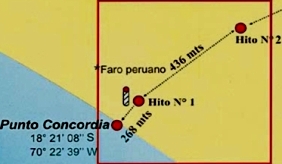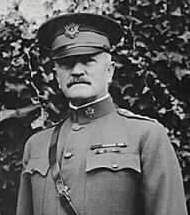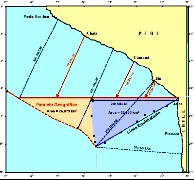Maritime delimitation Peru-Chile
How to stop further Chilean robbery
At the end of the War of the Pacific (1879-1883), the vanquished countries, Bolivia and Peru were coerced, under Chilean military occupation, into signing peace treaties thereby they relinquished sovereignty of coastal provinces to Chile1.
 |
In order to understand the size of the robbery perpetrated by Chile, suffice it to say that before the war Peru did not share a border with Chile--Bolivia lay in between. The war finished in 1883 by the signing of the Ancon treaty, whereby Peru gave over to Chile the province of Tarapaca (except the port city of Arica); the sovereignty of Arica and Tacna2--then under Chilean military occupation--would be decided in a plebiscite. However, Chilean procrastination and ethnic cleansing made the referendum impossible3 because Chile wanted to keep Arica under its sovereignty.
American General Jhon J. Pershing, appointed arbitrator by President Calvin Coolidge, made from 1923 to 1926 strenuous efforts to stop Chile from robbing so much land and expounded means for both Chile and Peru to sign an equitable treaty, but this proved an impossible endeavour given Chile’s deep-rooted greed for other countries’ land and natural resources. General Pershing understood that nothing could prevent the Chilean thieves from usurping Arica and Tarapacá. He took notice of the methods used by Chile to drive Peruvians out of Arica and Tarapacá. We can read the following4:
“Pershing described a typical incident on November 22, 1925. A Chilean carbineer and two companions broke into a Peruvian’s home, tied him up, and raped his wife. Led by the headman of a nearby Peruvian settlement, the victim’s compatriots attacked the Chilean military post and killed the rapist. On the Chilean side, Pershing wrote, ‘The dead carbineer is being heralded as a great hero and charges are flying thick and fast against the Peruvians.’”
 |
| .................Jhon J. Pershing |
The breach of the 1883 Ancon treaty--that meant outrageous procrastination, ethnic cleansing and war threats--allowed Chile to keep Peru’s Arica, as determined under a new treaty Peru was forced to sign in 1929. As we shall show below Chileans also refuse to recognise the seashore starting point of the common border with Peru, defined in that 1929 treaty. This disregard for international treaties exposes Chile as a disreputable country which unsuccessfully tries to pass as a law-abiding nation. Robbery-oriented Chile, a country accustomed to rob its neighbours’ land, has always staid true to its shameless motto “By reason or by force”.
Where the boundary begins
As both Chile and Peru face the Pacific Ocean, the 1929 treaty defines a borderline that starts on the seashore, in a point called “Concordia” (Concord), 10 kilometres north of the Chilean Lluta river (coordinates 18º 21’ 08” S and 70º 22’ 39” W). Therefore, any maritime delimitation between Chile and Peru has its starting point at the Concordia point.
This clear fact, that conforms to the international common practice, is rejected by Chile. Chilean politicians and diplomats claim that the Chile-Peru border does not begin at the Concordia point but at the boundary stone No. 1, two hundred and sixty eight metres inland!
Robbery upon robbery
Why do they say that? The answer is very simple. They are not satisfied with the Bolivian and Peruvian land they robbed in the War of the Pacific--they want more. Upon saying that the border begins at the boundary stone No. 1, they draw from that point a parallel line which by intersecting the seashore 250 metres north of the Concordia point and extending seawards strips Peru of 37 000 square metres of land.
 |
On the other hand, we must point out that in a normal situation an equidistance line should be drawn from the Concordia point seawards, and this line would make up for any loss of either of the parties--instead, the above said Chilean-drawn parallel line puts 36 000 square kilometres of Peruvian sea waters under Chile’s sovereignty.
International law provides that if the coastal line of two bordering countries changes its direction or angle, an equidistance line must be drawn seawards starting from the point at the seashore where the borderline begins (Concordia point for Chile and Peru). This line leads to an equitable maritime delimitation.
This is very important because back in 1952 Chile, Peru and Ecuador, coastal countries, signed a joint declaration to lay claim to 200 nautical miles from their seashores. The problem is that Peru does not have that 200 miles wide stripe all along its coastal line--the more it goes South, the more it narrows down, to a mere 0-5 miles at the boundary with Chile; whereas Chile, by drawing the above said parallel line, has 200 nautical miles all along its coast.
Taking into consideration that no treaty on maritime delimitation has been signed by Chile and Peru and that the Parliaments of Chile and Peru have never approved any such treaty, acting in good faith Peru requested Chile more than once to talk about these matters, but Chile consistently refused to recognise a problem of maritime delimitation existed. That’s why Peru, on March the 19th 2009, brought its case against Chile to the International Court of Justice.
_________________________________________
1 Bolivia’s Antofagasta and Peru’s Tarapacá. The loss of Antofagasta made of Bolivia a land-locked country.
2 Today Peru’s southernmost city.
3 Tacna’s Peruvian population suffered death treaths, murders, beatings and public humilliation. Peruvians living in Arica experienced a similar plight--those who did not accept Chilean citizenship were evicted from their homes.
4 Richard O’Connor: Black Jack Pershing (Library of Congress Catalog Card Number 61_8899).
At http://www.archive.org/stream/blackjackpershin030769mbp/blackjackpershin030769mbp_djvu.txt
Recorded on April the 15th, 2009 at 17:20 h.
